Agapanthus: description of species, planting and care rules

Agapanthus is a perennial ornamental flowering plant. With it, any garden bed will become more picturesque - the plant is characterized by abundant succulent foliage, delicate and fragrant flowers. Suitable for on-site and indoor cultivation. There are no particular difficulties with planting and caring for agapanthus, which allows you to break lush flower beds even in an apartment.
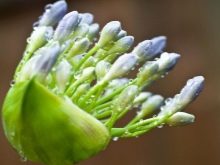

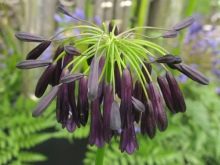
Description
The origin of agapanthus is South and Central Africa. Now the flower represents a separate family of Agapanths, but initially scientists assumed the relationship of Agapanthus to the onion, amaryllis and lily families.
The name of the plant in Latin is derived from the words "agape" and "anthos", which means "flower of love". In the wild in southern Africa, agapanthus grows off the coast and on mountain slopes. Blue shades of colors in the tone of sea water are a mesmerizing sight to look at.
The plant has a shallow but creeping and fleshy root system. Most of it is located close enough to the surface of the earth. Agapanthus leaves are dark green in color, reaching 70 cm in length. In the intervals between flowering, the "flower of love" continues to release fresh foliage, forming a lush green bush.

At the beginning of the flowering period, strong peduncles appear from 50 to 120 cm in height. Soon, a rounded large inflorescence with a diameter of 25-40 cm is formed on each of them.
Agapanthus flowers are funnel-shaped in shape, resembling bells, and the color options are different: from white to indigo.
One inflorescence consists of a bouquet of one hundred buds. Each flower grows from the top of the peduncle on a separate stem.
The length of the flower in the inflorescence is about 5 cm. Due to the fact that the buds bloom alternately, agapanthus flaunts for a long time in a blooming state. The flowering period is from July to October. A box with seeds appears on a faded peduncle.
Many growers practice home cultivation of the African lily. At home, the flower brings not only aesthetic pleasure, but also benefits, clearing the air from mercury and pathogenic microbes. The genus of agapanthus is not very rich in varieties, but in the process of cross-pollination of flowers, unique hybrids sometimes appear.

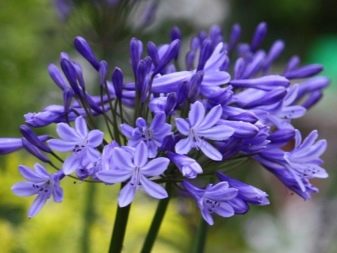
Types and varieties
The most common varieties can be selected from African, umbrella, oriental or bell-shaped species. Representatives of the genus differ in the growth of peduncles, the shape and color of bells and leaf plates.
The difficulty in identifying varieties lies precisely in the presence of many hybrids. Obtaining an interesting look can be achieved by crossing different varieties of agapantes. Officially, there are five varieties of agapanthus. But pollination offers growers much more choice among hybrid varieties.
- Bell-shaped. It differs in a slightly shorter deciduous rosette than the rest of the genus. The color of the petals is deep purple. Sheds leaves by winter.
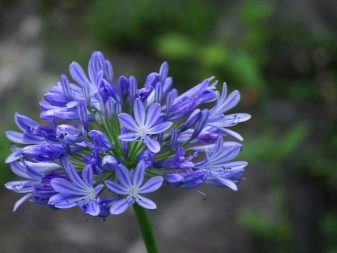
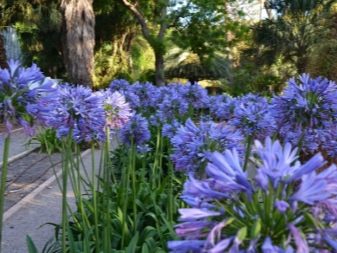
- African. An evergreen variety, reaching a height of 60 cm. On the site it is traditionally grown in volumetric deep flowerpots, and not in the open field. The petals are sometimes blue, sometimes lilac; milk stripes are rarely observed on them.
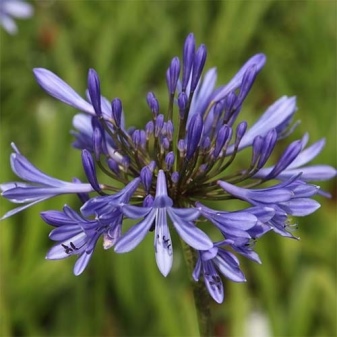
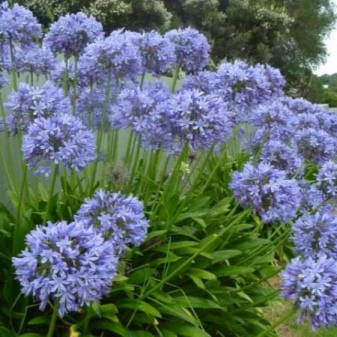
- Umbrella. Plant up to 75 cm high with blue-blue flowers. Otherwise, all signs are identical to the African species. Also known as "African lily" or "Abyssinian beauty".The tall perennial Agapanthus "Blue" also belongs to the umbrella species. The flowers are deep blue, bell-shaped, about 3.5 cm in diameter. They bloom from July to the first month of autumn. Great for growing on a windowsill or in a garden.
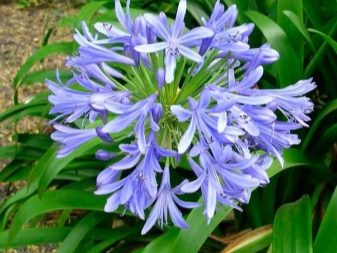
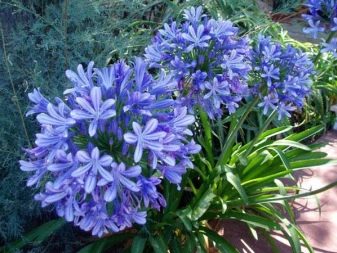
- Oriental. Evergreen with dull purple buds and shorter leaves. Grows up to 1 meter in height.
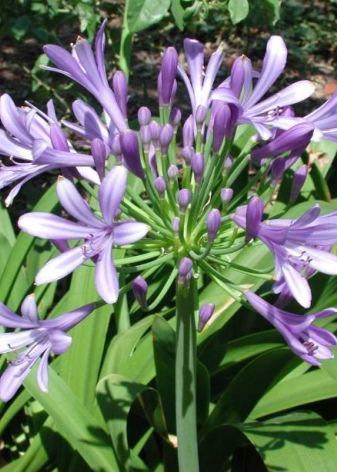
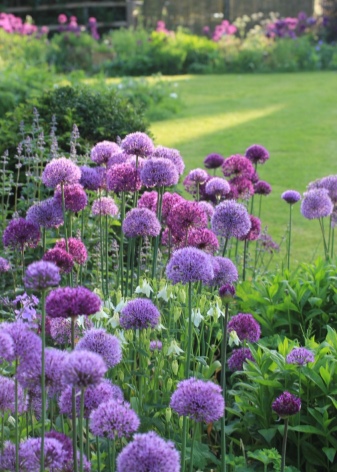
- Closed. The tallest species reaches 1.5 meters with the longest flowering period (until the last days of October). It got its name because of the "snickshey" shape of the buds, since they do not bloom completely. In color - from blue to almost ink shades.
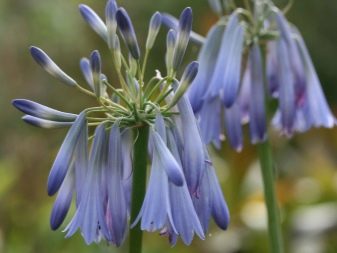
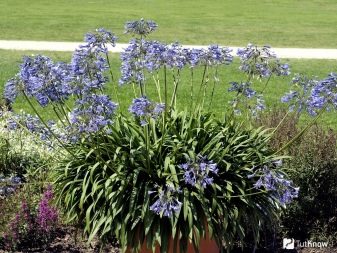
African lily hybrids are evergreen or deciduous. Among the mixed varieties, several are the most popular.
- Lilliputian. 30 cm tall, with dark purple flowers.
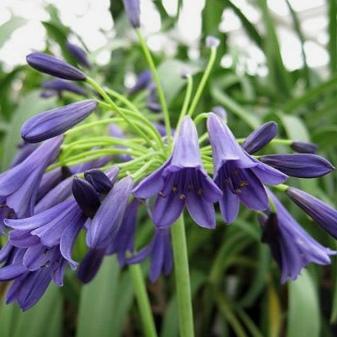
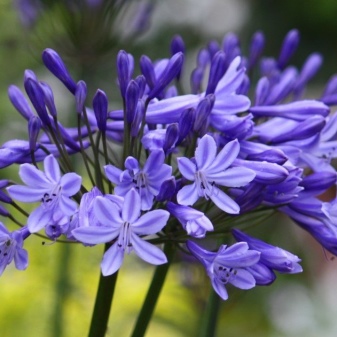
- Peter Pan... A dwarf species with sky-colored bells.
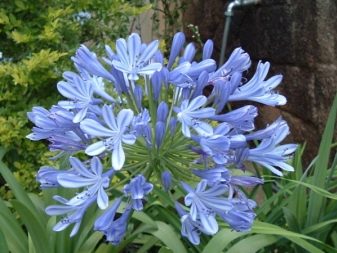
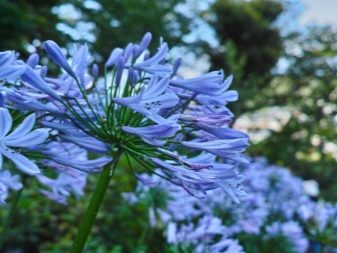
- "Albidus". A plant with snow-white flowers and a red patch on the perianth.
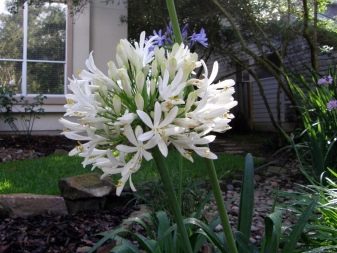
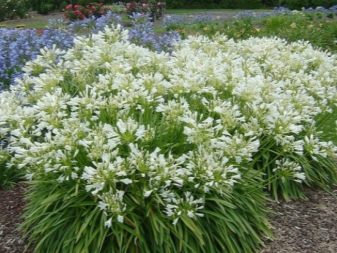
- "Albus" and "Albus Nanus"... Tall and dwarf variety with white inflorescences.
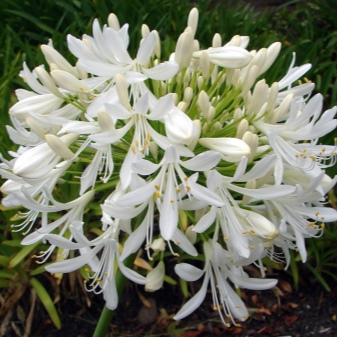
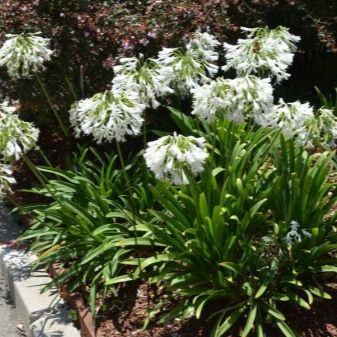
- "Variegata". A tall hybrid with sky blue flowers with white stripes.
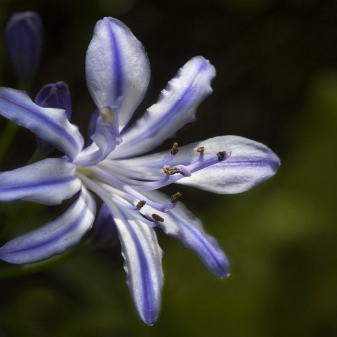

- Star Quality. The main difference is the meter-long "bare" peduncle, on which purple, blue or vanilla bells bloom.
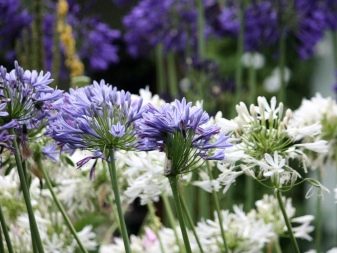
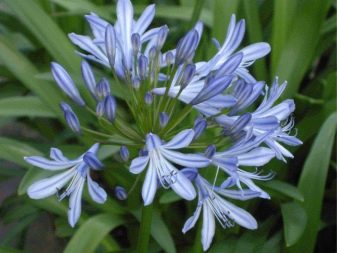
- Pinocchio. Variety of medium height with indigo colored petals. Traditionally considered a houseplant.
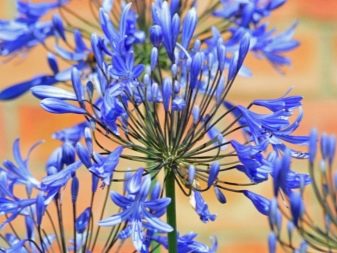
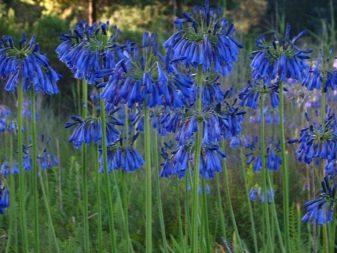
Care
Agapanthus is perfect as border flowers in the neighborhood with tenacious, dicentra, arabis, gravilat. The plant produces phytoncides. Its antibacterial properties are superior to garlic. But, unlike him, the flower smells fragrant.
But in order for the Abyssinian beauty to fully develop, she needs to provide quality care. This applies to any growing conditions. For the normal process of life, the plant needs regular watering, weakly acidic or neutral soil, warm air and sunlight.
Young plants are transplanted annually, and adults - once every three years. The transplant should be gentle so as not to injure the rhizomes. Be sure to have drainage material at the bottom of the pot.
During transplantation, it is allowed to reproduce by dividing the root. This is a very simple procedure: you only need to plant the delenki in pots and wait for rooting. Large pots are not needed - a young plant is better in a small container. The soil for transplantation is mixed from humus and turf (in two parts) and sand with leafy soil (in one part).
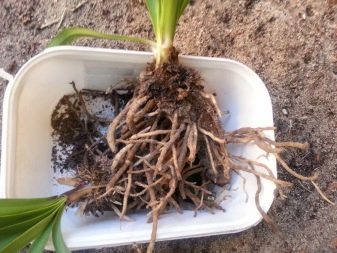

Unlike most flowering plants, an adult agapanthus flower needs a spacious pot. In crowded conditions, the plant will weaken and may stop growing. Drainage is also necessary when transplanting into a new pot. It is poured at least 2 centimeters to the very bottom, before filling the container with slightly acidic and nutritious soil.
When transplanting, the roots must be partially freed from adhering soil. At times it is advisable to mulch the top layer with peat and turf. This is to prevent drying out.
Basic rules for home care:
- agapanthus is transplanted into a spacious pot or barrel;
- a drainage layer is needed at the bottom, crushed stone (pebbles) is suitable;
- in winter, the air should not be higher than +15 degrees;
- in the cold season, watering is required rarely, in the form of wetting the soil to prevent the roots from drying out;
- in spring, it is better to transfer the container with a flower to a sunny windowsill or to another lighted place and switch to abundant watering until mid-autumn;
- on summer days, the African lily needs fresh air, so it is recommended to take the plant out of the house for the whole day.
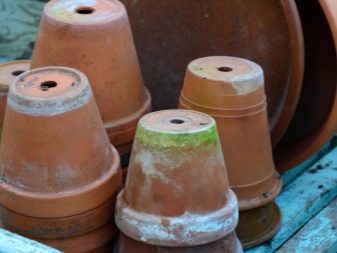
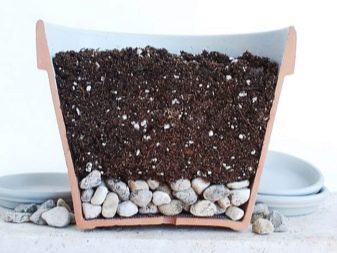
Landing
The African lily can be propagated in two ways.
- From seeds. Seedlings are sown in March in the ground mixed with sand. Sprinkle the seeds with soil, spray and cover with glass.It is necessary to ensure that the soil does not dry out, to maintain its moisture. Seedlings require daily ventilation - it is recommended to remove the glass for half an hour a day. When the sprouts hatch and get a little stronger, it's time to plant them in individual pots.
- Division of roots. This manipulation is combined with an agapanthus transplant in the spring. It is advisable to separate the medium-sized parts, since there is a possibility that the small ones will not bloom or will not take root. Planting is carried out in prepared moist soil.
Growing flowers in the open field.
The plant's love for a mild climate indicates its immunity to cold. The temperature, which has dropped below +10 C, signals the need to take measures to shelter the flower. For this purpose, a box sprinkled with sand or sawdust on top is suitable.
In regions where winter shows a harsh nature, before the onset of frost, a plant of the Agapantov family is dug up, identified in a box and taken to the house for the winter. With the arrival of spring, the flower is returned back. Gardeners in the Moscow region also practice wintering agapanthus in a room with a cool temperature, since winters in the local climate pass at a minus mark on the thermometer.
It is important to know that the lack of lighting contributes to the excessive stretching of the stalk of the African lily. This is fraught with breakage, so the plant needs a support or tying.
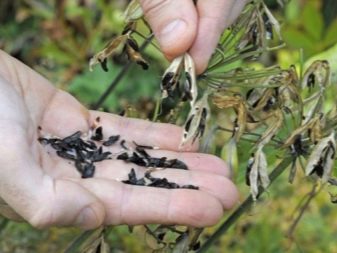
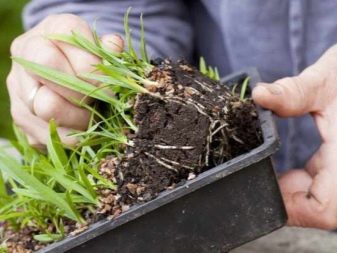
Outdoor planting principles.
- The garden area where the agapanthus is planted should be well lit. It is best to plant in an area with little shade, out of direct sunlight.
- The plant shows excellent development results in the cool season. The temperature + 10-12 C is very comfortable for the African lily, despite the fact that it is a rather warm and light-loving plant.
- There is no need to additionally moisturize the plant. Higher air humidity is necessary only in hot climates. Spraying or washing with a warm shower every day will give the plant the moisture it needs. Water must be taken soft so that traces of lime streaks do not remain on the juicy leaf blades. You must try not to wet the flowers themselves when watering. Water caught on the petals can cause them to wilt.
- Abundant watering is required from the beginning of the spring season to mid-October. Then it is gradually reduced.

Diseases and pests
The plant is afraid of waterlogging of the soil, in connection with which rotting of the roots may develop. The flower signals this by yellowing of the leaves. Therefore, it is so important to observe the correct watering regime.
In the summer, it should be regular and moderate, and in winter - minimal, but the soil should not be allowed to dry out.
Root decay requires an emergency transplant, removal of the affected areas and treatment of the sections with fungicidal preparations.
A plant of the Agapant family is susceptible to attack by insect pests: spider mites, thrips, mealybugs, aphids, scale insects. They settle on foliage and drink plant sap, so they can be detected by the changed leaves, the appearance of dots, spots, spider mites and whitish cobwebs, cotton-like lumps from the mealybug on them.
The removal of pests, first of all, should be mechanical: wipe the leaves with a cotton pad moistened with alcohol or soapy water.
Then you will need soil and plant cultivation. insecticidal preparation.
Another nuisance can happen in the form of snails and slugs. These pests are especially active at night. It will not be superfluous to install night lamps in the garden to scare away. A folk remedy also helps - a large eggshell scattered around the flower.
If you take good care of the agapanthus, the plant will not cease from year to year to delight the eye with its marvelous natural beauty.
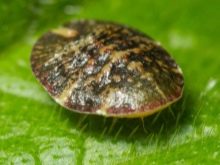


For information on how to care for agapanthus, see the video below.































































































The comment was sent successfully.